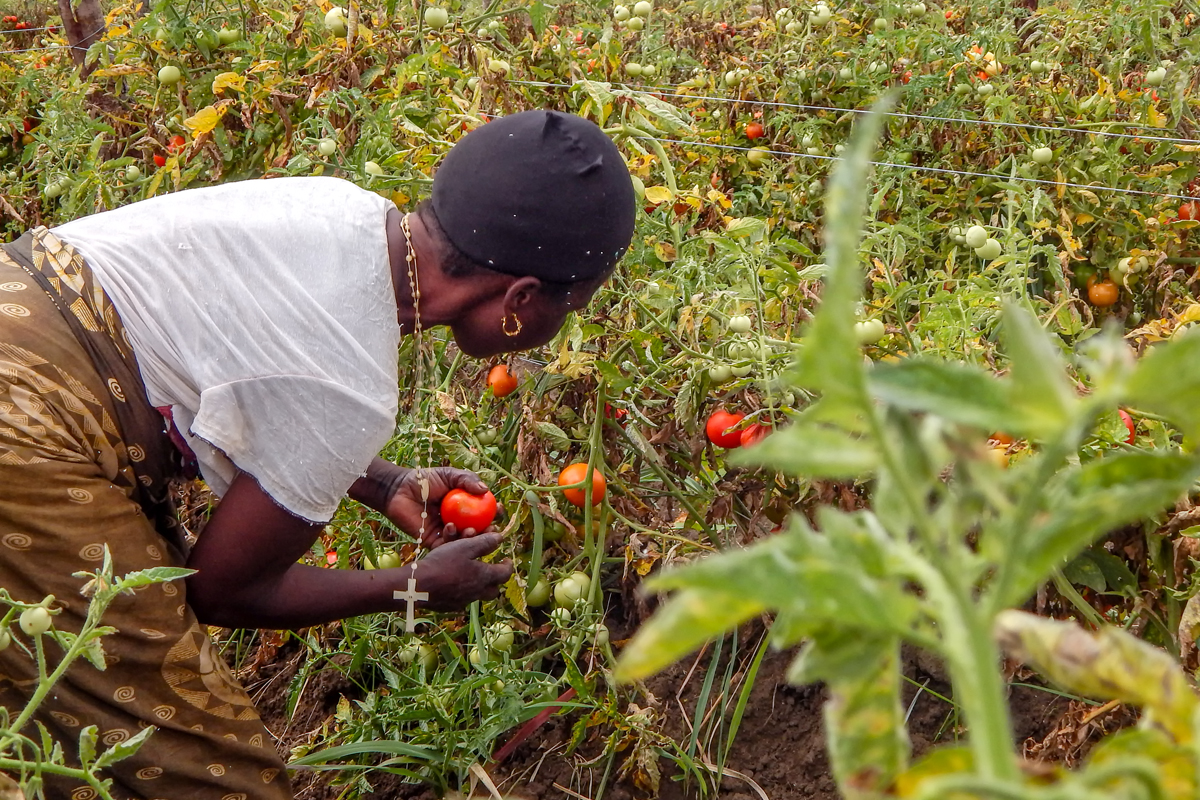
Prudence Phiri, GPJ Zambia
Kasambo Banda, a small-scale farmer who grows soybeans, cowpeas and groundnuts (right), and employee Cosmas Mwape remove weeds on her farm in the Chibombo District in central Zambia. Banda, who previously grew maize, says she no longer raises that crop, because the government's most recent purchasing price is lower than in previous years.
CHIBOMBO, ZAMBIA — In the scorching sun, Kasambo Banda clears weeds on her farm in Chibombo District in central Zambia.
Despite erratic rains, she hopes for a good harvest and a higher profit than she had from growing and selling maize last farming season, from October 2016 to April 2017. For a year, Banda cultivated maize, a staple crop in Zambia that she says grows well when rain-fed.
But now she is raising other rain-fed, widely consumed crops.
“I have decided to grow soybeans, cowpeas and groundnuts,” she says.
While small-scale farmers produce up to 80 percent of maize grown in the country, according to a 2011 report from the Zambia Development Agency, the most recent data available, many are no longer growing the crop. Farmers say irregular rainfall patterns and pests contributed to the change in their practices – and that the government is also to blame.
Last year, Zambia’s Food Reserve Agency purchased a total of 500 million kilograms (more than 1.1 billion pounds) of maize from the country’s small-scale farmers, to be sold to millers across the country, says Dora Siliya, former minister of agriculture. Small-scale farmers produced a bumper crop of 3.6 billion kilograms (7.9 billion pounds) in 2017, she says.



Each June, the government announces a new price at which it and other buyers will purchase the crop from farmers across the country. Last year, the Food Reserve Agency paid 60 Zambian kwacha ($6) per 50 kilograms (110 pounds) of maize, a price farmers say is lower than in previous years, causing losses in their businesses.
In 2016, for example, the Food Reserve Agency paid 85 kwacha ($8.60) per 50 kilograms, says Calvin Kaleyi, media and public-relations manager at the Zambia National Farmers’ Union, an organization of small-to-large-scale farmers and agribusinesses.
It was this price that attracted Banda to maize farming, after years of selling broiler chickens, she says. Between October 2016 and April 2017, she produced 300 50-kilogram bags of maize. But in July, she sold all of it to the Food Reserve Agency at 60 kwacha ($6) per bag.
By the end of the harvest season in April 2017, Banda says, buyers other than the Food Reserve Agency were hesitant to purchase her maize, hoping that the government would announce a lower price for the crop just a month later.
Her sales brought in 18,000 kwacha ($1,833), but she spent 17,000 kwacha ($1,731) to farm the crop. Banda describes her profit, 1,000 kwacha ($102), as minimal.
“From the previous floor price, I was encouraged to grow maize, but the current price is very discouraging,” she says.
Gertrude Mwale, another farmer, says she started growing tomatoes this year after harvesting about 1,000 50-kilogram bags’ worth of maize last farming season. She has been a maize farmer for eight years, but in the last farming season she made less money than she spent to grow the crop.



“We are not into farming for fun, but to make a living,” she says. “And if we are going to grow crops that will not benefit us, then what’s the use?”
Since August, the government’s 10-percent export tax on maize has also limited business among small-scale farmers, says Kaleyi. Buyers who often purchase the crop for exports are doing so less regularly. An outbreak of armyworms forced some farmers to buy pesticides, Banda says. That blight, coupled with erratic rainfall, made farmers unable to produce as much maize as in the previous season.
“A lot went into last season’s farming,” she says. “In certain instances, the crop was totally destroyed, and we had to replant.”
As farmers turn to other crops, Kaleyi says, some Zambians fear that maize shortages are looming.
Andrew Chintala, president of the Millers Association of Zambia, says shortages are likely, given the shift in farming practices across the country.
“Yes, we will experience a shortage going by the erratic rains and the boycott by some farmers,” he says. But the government claims otherwise, he adds.
Siliya says the Food Reserve Agency’s stock of 500 million kilograms (more than 1.1 billion pounds) of maize is enough to feed the population. But she says the government encourages farmers to grow other crops.
“We need to stop thinking food is just nshima [maize-meal porridge],” she says. “It’s time we started eating other foods, so that even when we do not have maize, we will not starve.”
Prudence Phiri, GPJ, translated some interviews from Nyanja.







